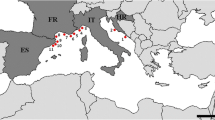Summary
The flagellar apparatus of 3 isolates ofHeterosigma akashiwo (Hada) Hada has been studied by serial sectioning. The two basal bodies lie at almost right angles to one another, but in a different plane, and are interconnected by an extensive root system. This consists of three roots (i) a massive cross-banded fibrous root (= rhizoplast) which extends from near the proximal ends of both basal bodies to the anterior surface of the nucleus, (ii) a compound microtubular root with a layered structure, associated with the hairy anterior flagellum and extending to the anterior surface and (iii) the rhizostyle which passes between the two basal bodies leading anteriorly to a vesicle in the flagellar groove region and following the nucleus posteriorly terminating deep in the cytoplasm. Both the characteristic arrangement of the basal bodies and the presence of the complex layered structure are characteristic of theRaphidophyceae. The broad microtubular root, however, to which the layered structure is attached, appears to be characteristic of nearly all heterokont algae, fungi and protozoa so far examined. Thus, our findings have important implications on phylogenetic relationships within the heterokonts and lead us to question whether some of the present classes such as theChrysophyceae andXanthophyceae are indeed natural groups.
Similar content being viewed by others
References
Barr DJS, Allan PME (1985) A comparison of the flagellar apparatus inPhytophthora, Saprolegnia, Thraustochytrium, andRhizidiomyces. Can J Bot 63: 138–154
Bouck GB, Brown DL (1973) Microtubule biogenesis and cell shape inOchromonas. I. The distribution of cytoplasmic and mitotic microtubules. J Cell Biol 56: 340–359
Carter N (1937) New or interesting algae from brackish water. Arch Protistenk 90: 1–68
Christensen T (1980) Algae, a taxonomic survey. Fasc 1, p 1–216. AiO Press, Odense, Denmark
Duckett JG, Bell PR (1977) An ultrastructural study of the mature spermatozoid ofEquisetum. Phil Trans Roy Soc Lond B Biol Sci 277: 131–158
Gibbs SP, Chu LL, Magnussen C (1980) Evidence thatOlisthodiscus luteus is a member of theChrysophyceae. Phycologia 19: 173–177
Hara Y, Chihara M (1982) Ultrastructure and taxonomy ofChattonella (classRaphidophyceae) in Japan. Jap J Phycol 30: 47–56 (in Japanese)
—— (1985) Ultrastructure and taxonomy ofFibrocapsa japonica (classRaphidophyceae). Arch Protistenk 130: 133–141
—,Inouye I, Chihara M (1985) Morphology and ultrastructure ofOlisthodiscus luteus (Raphidophyceae) with special reference to the taxonomy. Bot Mag Tokyo 98: 251–262
Heywood P (1972) Structure and origin of flagellar hairs inVacuolaria virescens. J Ultrastruct Res 39: 608–623
Hibberd DJ (1976) The ultrastructure and taxonomy of theChrysophyceae andPrymnesiophyceae (Haptophyceae): a survey with some new observations on the ultrastructure of theChrysophyceae. J Linn Soc (Bot) 72: 55–80
—,Leedale GF (1972) Observations on the cytology and ultrastructure of the new algal class,Eustigmatophyceae. Ann Bot 36: 49–71
Hoffman LR, Vesk M, Pickett-Heaps JD (1986) The cytology and ultrastructure ofHydrurus foetidus (Chrysophyceae). Nord J Bot 6: 105–122
Leadbeater BSC (1969) A fine structural study ofOlisthodiscus luteus Carter. Br phycol J 4: 3–17
Loeblich AR III,Fine KE (1977) Marine chloromonads: more widely distributed in neritic environments than previously thought. Proc Biol Soc Wash 90: 388–399
—,Smith VE (1968) Chloroplast pigments of the marine dinoflagellateGyrodinium resplendens. Lipids 3: 5–13
Manton I (1964) A contribution towards understanding of “The primitive Fucoid”. New Phytol 63: 244–254
Massalski A (1969) Cytological studies on filamentousXanthophyceae. PhD Thesis, University of Leeds
Mignot JP (1967) Structure et ultrastructure de quelques chloromonadines. Protistologica 3: 5–25
— (1976) Compléments à l'étude des chloromonadines, ultrastructure deChattonella subsalsa Biecheler flagellé d'eau saumâtre. Protistologica 12: 279–293
Moestrup Ø (1970) On the fine structure of the spermatozoids ofVaucheria sescuplicaria and on the later stages in spermatogenesis. J mar biol Ass UK 50: 513–523
— (1982) Flagellar structure in algae: a review, with new observations particularly on theChrysophyceae, Phaeophyceae (Fucophyceae), Euglenophyceae, andReckertia. Phycologia 21: 427–528
Okaichi T (1983) Marine environmental studies on outbreaks of red tides in neritic waters. J Oceanog Soc Japan 39: 267–278 (in Japanese)
Provasoli L, Mclaughlin JJA, Droop MR (1957) The development of artificial media for marine algae. Arch Mikrobiol 25: 392–428
Riley JP, Wilson TRS (1967) The pigments of some marine phytoplankton species. J mar biol Ass UK 47: 351–362
Roberts KR, Stewart KD, Mattox KR (1981) The flagellar apparatus ofChilomonas paramecium (Cryptophyceae) and its comparison with certain zooflagellates. J Phycol 17: 159–167
Rowley JC, Moran DT (1975) A simple procedure for mounting wrinkle-free sections on formvar-coated slot grids. Ultramicros 1: 151–155
Schnepf E, Deichgräber G, Röderer G, Herth W (1977) The flagellar root apparatus, the microtubular system and associated organelles in the chrysophycean flagellate,Poterioochromonas malhamensis Peterfi (syn.Poteriochromonas stipitata Scherffel andOchromonas malhamensis Pringsheim). Protoplasma 92: 87–107
Toriumi S, Takano H (1973)Fibrocapsa, a new genus inChloromonadophyceae from Atsumi Bay, Japan. Bull Tokai Reg Fish Res Lab 76: 25–35
Vesk M, Dwarte DM (1980) Ultrastructure of an unusual marine unicellular alga. Micron 11: 507–508
—,Puttock CF (1980) Fixation of marine unicellular algae. Micron 11: 505–506
Author information
Authors and Affiliations
Rights and permissions
About this article
Cite this article
Vesk, M., Moestrup, Ø. The flagellar root system inHeterosigma akashiwo (Raphidophyceae) . Protoplasma 137, 15–28 (1987). https://doi.org/10.1007/BF01281173
Received:
Accepted:
Issue Date:
DOI: https://doi.org/10.1007/BF01281173




